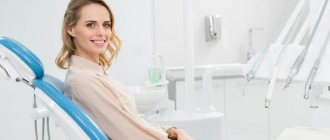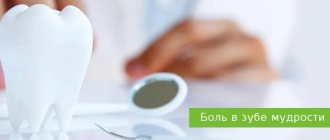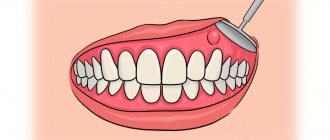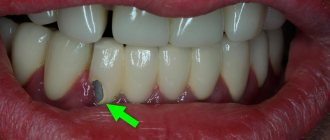Primary self-help
But sometimes a tooth reminds itself suddenly: on the road, on vacation, late in the evening, when there is no immediate opportunity to see a doctor, nor the strength to endure any longer. In such a situation, you can use tips for quickly combating toothache:
- Rinsing. Warm rinsing helps clean the aching tooth from pieces of food, plaque and bacteria. The most effective recipes: a solution of soda or salt, a few drops of iodine or a furatsilin tablet in a glass of water, a light pink solution of potassium permanganate. Infusions of herbs also help well: chamomile, peppermint, sage, calendula, calamus, individually or in a mixture. You need to rinse every time after eating, as well as every hour. You can also make baths from infusions of these herbs for 15-20 minutes.
- Dental floss. You can try to gently clean the interdental space while the pain subsides using dental floss.
- Clove oil. A drop of this oil should be applied to the aching tooth using an ear stick.
- Strong alcohol . If there are no contraindications, you can rinse your mouth with vodka, whiskey, cognac or any other strong alcohol. The gums will absorb some of the alcohol, which will dull the pain.
- Painkiller. You can take any over-the-counter painkiller according to the regimen indicated in the annotation.
- Massage. You can try for 3-5 minutes to massage the area between the index and thumb on the side of the diseased tooth or the top of the auricle.
These steps will help ease the pain enough to allow you to wait until dental clinics open.
It is important to remember that neither these nor any other express methods will get rid of the cause, so without a visit to the dentist, the tooth will remind itself again and again.
Why does tartar form on teeth?
There is always a certain amount of bacteria present in the oral cavity. This is fine. Moreover, bacteria help in digestion by starting the process of decomposition of food already during chewing.
Bacteria are found on the surface of all oral tissues, including teeth. The latter are protected from the harmful effects of microorganisms by enamel. Bacteria cannot penetrate through it.
But, nevertheless, nothing prevents bacteria from accumulating on the surface of the enamel. This biofilm is easily removed with everyday hygiene - brushing, flossing and irrigating. But in some cases - for example, due to untimely removal - the plaque begins to thicken. The reasons for this are:
- Excessive consumption of sweet foods, sugar, foods high in carbohydrates. All this creates a breeding ground for microorganisms;
- Use of low-quality hygiene products, untimely cleaning;
- Smoking. Tobacco smoke destroys the structure of the enamel, forming roughness, cavities and cavities on its surface;
- Irregularity of the dentition, malocclusion;
- Diseases of the digestive system, hereditary predisposition.
Bacterial plaque is easily removed. However, at some point it begins to petrify – that is, to become denser and acquire a mineral structure. And turns into tartar.
Tartar can no longer be removed with everyday hygiene products. It cannot be brushed or flossed off, and even a waterpik cannot destroy it. At the same time, bacteria in this colony continue to destroy both the tooth and the soft tissue located next to it. As a result, itching, swelling, bleeding begins, and increased sensitivity appears.
What not to do
There is a lot of “harmful” advice that will only worsen the situation. So, what not to do:
- Do not heat. Under no circumstances apply heating pads, scarves, compresses, warming tampons, etc. to a sore tooth.
- Do not apply tablets. You can often come across advice to put an aspirin tablet on a sore tooth, but this can only cause a chemical burn.
- Do not take antibiotics. In the treatment of certain dental diseases, doctors often use antibiotics. But only a specialist can develop an effective and correct regimen for taking them.
Is it possible to remove tartar at home?
On the Internet and in printed publications you can find many recipes for removing stones yourself at home. This includes a mixture of black radish with lemon juice, decoctions of walnut bark, and other incredibly practical remedies that can be found in any garden.
But the problem is that they practically don't work. Decoctions of herbs and plants can have a positive effect on the soft tissues of the oral cavity, yes. But they won’t be able to cope with mineral deposits. Daily brushing will help remove bacterial biofilm, but not tartar. Attempts to soften mineral plaque with acid, as was done 25-50 years ago, will also not lead to anything good and can cause pain in already inflamed gum tissues and increase the sensitivity of the enamel.
Mineral tartar, unfortunately, cannot be completely removed at home. Not strawberry paste, not a mixture of black radish with lemon, not walnut bark decoctions, not soda, not a swab with hydrogen peroxide. Not a single one, even the most advertised brush or paste, can destroy mineral structures. But scratching, erasing healthy enamel or causing its increased sensitivity is quite possible.
The only effective and safe way to remove mineral plaque (tartar) from the surface of the enamel is to consult a dentist.
Baths after tooth extraction
Since rinsing after the removal procedure is prohibited, it is necessary to make baths.
Doctors usually recommend making baths using soda and salt, medications or decoctions of various medicinal herbs. For these purposes, drugs such as Miramistin and an aqueous solution of Chlorhexidine are suitable.
The procedure is easy to carry out. You just need to put a small amount of bath liquid in your mouth, tilt your head so that the liquid moves to the area of the pulled out tooth, and freeze in this position for 30-60 seconds. There is no need to take any active action; the medicinal solution should simply gently wash the damaged gum tissue. After this, the liquid must be spat out.
Antiseptic or therapeutic baths are recommended to be done every 3 hours during the day, preferably after eating and cleansing the mouth.
After the patient has taken a bath, it is advisable not to eat any food or even drink for 1 hour.
What can and cannot be done after tooth extraction
- What to do after tooth extraction
- What to do after wisdom tooth removal
- What not to do
- What do we have to do
- What to do after tooth root removal
- Baths after tooth extraction
- What to do after a child’s tooth extraction
- What to do after removing a tooth with a cyst
- Temperature rises after tooth extraction
Tooth extraction is a major dental operation.
The recovery period after such a procedure can take some time and last from three days to seven days. There are indications and contraindications for what measures the patient needs to take to ensure that the rehabilitation process goes as quickly and successfully as possible. If you strictly follow the dentist’s recommendations and the general rules of the postoperative period, you can significantly bring the moment of recovery closer and avoid unpleasant or even dangerous complications. Rules of conduct during recovery after a doctor has pulled out a tooth may differ depending on the severity of the operation performed, its type, the general health of the patient, his habits and age. However, there are general recommendations that are relevant for any postoperative situation.
What to do after tooth root removal
Root removal is often accompanied by circumstances that complicate the dentist’s work and can negatively affect the duration and course of the recovery period.
In order for rehabilitation to progress at a normal pace and tooth reconstruction to begin, the patient must follow the rules of the recovery period.
First of all, it is necessary to avoid the occurrence of inflammation in the area of the torn root. For this you will need:
- Observe the rules of personal hygiene;
- Do not overheat the head area;
- Do not rinse or touch the affected area with your tongue;
- Do medicinal baths, take painkillers, start taking antibiotics if the doctor gives such a recommendation.
You should try to protect the area of the torn root as much as possible, since any infectious process at the site of removal can lead to serious complications.
Professional tartar removal
The most modern, effective and gentle way to remove tartar is ultrasonic cleaning. It is carried out in dental clinics. Hygienists or periodontists specialize in such procedures.
Before performing ultrasonic dental tartar removal, the doctor, guided by the main medical principle “Do no harm!”, assesses the condition of the patient’s oral cavity. Determines whether there are any contraindications. Selects a suitable nozzle for the ultrasonic cleaning device.
During ultrasonic exposure, the structure of the mineral plaque is destroyed. And in most cases this happens from within. Tartar simply falls off the surface of the enamel, falls out of periodontal pockets and interdental spaces.
After this, the enamel is polished. This is necessary in order to prevent the appearance of plaque for a long time. The result is not only noticeable - it is literally tangible. You can run your tongue over the surface of the enamel - it will be clean, smooth and tactilely pleasant.
If tartar has penetrated deep into periodontal pockets or has damaged the integrity of the enamel, causing increased sensitivity, the dentist can also use local anesthesia. This is necessary to make the procedure comfortable and painless for the patient.
What to do after removing a tooth with a cyst
After the doctor removes a tooth with a cyst, you need to follow the general recommendations of the recovery period, but pay special attention to reducing the likelihood of infection of the wound.
In the initial period after the procedure, it is necessary to cool the sore side of the jaw by applying 3-4 cold compresses. Next, you need to ensure that the operated part of the face does not overheat. It is forbidden to make warming compresses, take hot baths, or sunbathe. For pain relief, you can take medications prescribed by your doctor.
It is necessary to avoid injuring the healing hole - the food is soft or liquid, not hot; brush your teeth as carefully as possible; Do not rinse your mouth. It is necessary to limit physical activity and monitor local and general temperature. If pain, high body temperature and swelling lasts more than 2 days, consult a doctor. If pus begins to discharge or there is an unpleasant odor coming from the hole, consult a doctor immediately.
Risk factors that increase the likelihood of developing gonarthrosis:
Insufficient water intake.
There are no blood vessels in cartilage tissue; the substances necessary for nutrition come from the synovial fluid. With insufficient water, the volume of the synovium decreases. The cartilage loses its elasticity, cracks, friction in the joint capsule increases, pain and a characteristic crunch occur. To support cartilage tissue and mitigate the course of the disease, drink at least 2 liters of water per day.
Intense physical activity.
To maintain freedom of movement, after 40 years you need to unload your joints. Wear shoes with shock-absorbing soles, alternate long static loads with rest while sitting or walking, and for heavy loads, wear a knee brace.
Low physical activity.
Cartilage tissue receives less oxygen and nutrients, muscles lose strength. They help relieve pain from arthrosis of the knees, stimulate the supply of nutrients to the periarticular tissues: swimming, hiking, skiing, Nordic walking, cycling.
Overweight.
Excess kilograms increase the likelihood of arthrosis 4 times; meniscus tears and microtraumas of cartilage occur more often. They will slow down the rate of destructive processes and help you lose weight: limited salt intake, vegetables and herbs, jellied dishes, fermented milk products, low-fat cheeses, lean meat.
Symptoms of gonarthrosis
The severity and duration of symptoms, external changes in the knee joint, and what kind of pain occurs with arthrosis depend on the stage of the destructive process.
Stage I.
The changes in the cartilage are minor, the surface becomes dry, and microtraumas appear. Osteophytes (bone growths) are visible on an x-ray. Pain occurs after physical activity, when climbing stairs, and the knee ache in damp weather. The kneecap is not deformed, morning stiffness goes away after a few movements.
Stage II.
The cartilaginous layer becomes thinner and disappears in some areas. The synovial membrane becomes inflamed. An X-ray examination reveals multiple osteophytes, narrowing of the joint space, and compaction of bone tissue. Worries about swelling and deformation of the knee, excruciating pain when bending and moving, severe aching when the weather changes, after hypothermia. There is stiffness, crunching and clicking in the joints. At the second stage of arthrosis, aching pain at night leads to insomnia, pain does not go away at rest.
In the photo (stages 1-4). The last image shows the destruction of bone tissue.
Stage III.
The cartilage is destroyed almost completely, the knee increases in size, the gait becomes unstable, and lameness appears. The crunching in your knees can be heard even by those around you. It is difficult to walk short distances, climb stairs without using a cane, or get on a bus. The radiograph shows destroyed menisci and ligaments, extensive ossification, and deformed articulating surfaces. The cutting pain bothers me when moving and at rest, and intensifies after walking 500 meters. The ability for self-care decreases.
IV stage
.
In the absence of adequate treatment or non-compliance with recommendations, the cartilage is completely destroyed, and the bones of the knee grow together. Motor ability is lost and disability occurs.
Temperature rises after tooth extraction
A slight increase in general body temperature or local temperature in the area of the operation is considered normal. This is the body's natural reaction to dental surgery.
If the temperature stays within 37-38° C, there is no need to bring it down. If it rises above 38° C, you need to take antipyretic drugs. Avoid using aspirin as it may cause bleeding from the socket.
An increase in temperature over a long period (2 or more days in a row), accompanied by signs of inflammation - severe pain, swelling, swelling of soft tissues, an unpleasant odor from the wound, are direct indications for urgent medical attention.
What to do after wisdom tooth removal
The third molar is usually pulled out due to inflammation that appears around it. At the same time, pus and infectious agents are likely to get into the wound. Therefore, in the postoperative period, the patient must follow general recommendations, as well as be as attentive as possible to his feelings, and note the slightest changes in his condition.
As soon as the hole stops bleeding, you should immediately remove the compression tampon. Its presence in the wound provokes the proliferation of bacteria and increases the likelihood of the onset of an inflammatory process.
The patient should be prepared for the fact that his gums will hurt for 3-5 days after the procedure. You need to purchase recommended anesthetics and take them on schedule. If the pain syndrome has become stronger, swelling of the face and gums increases over the course of several days, the elevated temperature does not subside, and an unpleasant odor begins to come from the socket, you need to call the dentist.
Which specialist should I contact?
It all depends on the reason why your stomach hurts. Initially, you should contact a therapist who works at (academician Roitberg’s clinic). He will perform a diagnosis and then refer you to the right specialist. If the diagnosis is fibroids, then you will need to consult a gynecologist (), if a person has kidney stones, then you need a nephrologist (), if you have diagnosed a duodenal or gastric ulcer, then you need the help of a gastroenterologist (). In case of ovarian torsion or appendicitis, the patient is referred to a surgeon (), and with bruises and injuries the patient will be treated by a therapist ().
To contact JSC "Medicine" (metro Mayakovskaya, metro Belorusskaya, metro Tverskaya, metro Chekhovskaya), you should dial phone numbers or drive up in person. If you have abdominal pain on the left side and want to reach a therapist, who should always begin examining the patient, dial the phone number.
What to do after a child’s tooth extraction
After removing a child’s baby or molar teeth, parents should closely monitor the baby’s condition and well-being.
It is necessary to ensure that the child follows the following rules:
- Do not rinse your mouth or spit, as this may cause the blood clot to be removed from the socket;
- Did not engage in vigorous physical exercise and did not overheat;
- Brush your teeth efficiently and responsibly, avoiding the injured area with a brush;
- Take the necessary medications in full and according to the schedule established by the doctor;
- Carefully and promptly made baths with antiseptic or medicinal products;
- He did not put any foreign objects in his mouth and did not touch the socket with his fingers or tongue.
The child’s body temperature, swelling of soft tissues and the child’s breath must be monitored. In case of complications, consult a doctor immediately.
What should you not do if you have a toothache?
Some actions can aggravate the problem, so these should be avoided:
- Applying heat, rinsing the mouth with hot liquids. If the pain is acute, this indicates an inflammatory process or an infectious lesion. In this case, heat increases blood flow to the sore spot, which can make the problem worse. In addition, neighboring teeth may also suffer from this;
- Increased bed rest. If you experience pain in a tooth, you should not lie down a lot, and this is also due to the flow of blood to it, which increases blood pressure. It is recommended to endure the pain, if not on your feet, then at least in a sitting or semi-sitting position. Of course, this is not a recommendation that answers the question of what to do if your tooth hurts at night, because sleeping even half-sitting is uncomfortable. In such a situation, the best ways are to rinse your mouth and take painkillers at night;
- Mechanical impact on the tooth and tissues around it. Eating and hygiene procedures should be done as carefully as possible, trying to avoid the sore spot.
All these methods of what to do if a tooth hurts are aimed only at relieving symptoms, but they do not help get rid of the disease that caused them. Therefore, as soon as pain makes itself felt, you should immediately make an appointment with a doctor who will identify the problem and help solve it.
Did you like the article?
Rate: ( 5.00 out of 5)
Loading…
Etiology of the disease
Any toothache - acute, aching, hot flash or constant - is caused by the negative impact of a certain factor on the nerve endings located in the pulp. The most common root cause of discomfort is deep caries: destruction of the enamel layer and dentin underneath to such an extent that the nerves in the crown react to thermal or taste stimuli, calming down after they disappear. In addition to caries, the pain syndrome may be caused by mechanical cracks in the hard tissues of the crown, exposure of dentin in the cervical area, or erroneously inserted filling material into the hole.
Much more unpleasant pain is accompanied by pulpitis, which is a logical development of caries: at this stage, an infection that has penetrated into the pulp chamber provokes inflammation of the soft tissues. For this reason, the pain does not subside even for a minute, and at night it even tends to intensify - its strength is so great that it radiates stabbing sensations to the area of the temporal lobe and ear (in the direction of the trigeminal nerve).
Similar processes can be considered periodontitis and periodontitis - inflammation of the tissues surrounding the crown and its roots in the gum, leading to swelling of the periodontium and weakening of the periodontal ligaments, which threatens the integrity of the entire tooth.
How to avoid tartar formation
Tartar prevention is a simple and affordable procedure. It will help protect not only from mineral plaque, but also from other dental diseases. To avoid the appearance of tartar, you must:
- Brush your teeth regularly. Twice a day, morning and evening, 2-3 minutes. You shouldn’t lean on the toothbrush so as not to scratch the enamel, but you shouldn’t move it like a feather either. Select the optimal pressing force;
- Use a variety of oral hygiene products. Flosses will help remove mineral plaque from the interdental spaces, irrigators - from periodontal (gum) pockets, rinses - get rid of harmful microorganisms;
- Use quality home hygiene products. Don’t skimp on toothpaste—dentist services can still cost more than the 50-100 rubles you managed to save;
- Eat 4-6 times a day, but little by little. You should not snack every few tens of minutes, especially snacks like chips, cookies or candy;
- Make it a habit to rinse your mouth with water after every meal. This will help wash away microorganisms, bacterial plaque and food particles;
- Eat more solid, healthy foods. For example, snack on carrots and apples. But you should refuse soft and high-calorie foods (cookies, cakes, etc.);
- Visit your dentist regularly.
These tips will help protect not only from tartar, but also from other dental problems. They will also have a positive effect on the gastrointestinal tract. This means that the rest of the body will say “Thank you.”
Our dental center will not only help you deal with tartar through professional cleaning using modern equipment, but will also teach you proper daily oral hygiene. The procedure will take about an hour, will be painless and calm, and immediately after its completion you will be able to delight those around you with your beautiful, confident and snow-white smile!
Prevention
These rules should be followed by all people who experience pain in the left lower abdomen:
- control your stress and its level. To do this, you should meditate and do stretching exercises. Very often, stomach problems arise due to stress. Stretching, meditation will relax the body, mind, reduce pain in the left abdomen;
- Exercise regularly if your stomach hurts on the lower right side. Thanks to constant exercise, constipation is prevented and metabolism is accelerated. In addition, sport helps strengthen the digestive tract, cleanse the intestines, and ensure efficient functioning of the stomach;
- fill out a food diary. Write down all the dishes you ate throughout the day there. This will help you understand why your stomach hurts. You can prescribe your diet for a week, and it is important to indicate even the amount of food consumed. You should also write down your feelings during abdominal pain in your diary (the nature of the pain, their duration);
- watch your weight. Just because you're overweight and not much of it, doesn't mean you can forget about heartburn. Scientists say that the layer of fat puts pressure on the stomach, causing gastric juice to rise into the esophagus, and this guarantees heartburn;
- drink more water if your stomach hurts (about 2.2 liters). To have regular bowel movements and digest food, you need to drink enough liquid. Otherwise, hemorrhoids, polyps, and painful constipation are possible;
- get plenty of rest. If there is a stomach virus in the body, then you should be at peace and have strength. In the case of acid reflux, lack of adequate sleep can lead to serious consequences.











